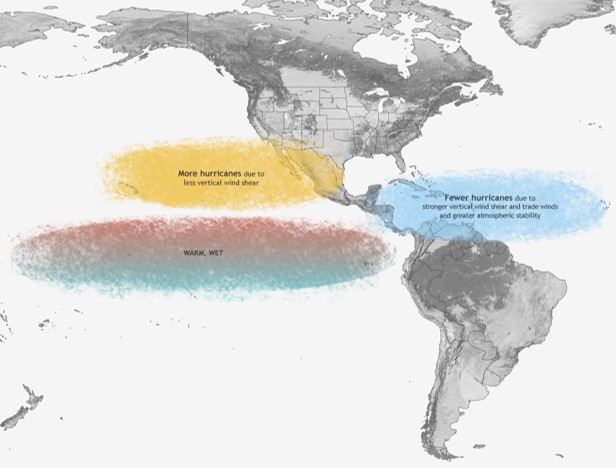1.5 Climate Variability vs Climate Change and its effect on Natural Hazards
Laura J. Brown
Disaster risk management has relied on the premise that the climate system remains stable. Extreme weather and climate events interacting with exposed and vulnerable human systems can lead to disasters.
Climate Variability
Many of these events result from natural climate variability, short-term (years or less) conditions controlled by internal climate system processes. For example, El Niño-Southern Oscillation (ENSO) events occur roughly every 3 to 7 years. ENSO phenomena, El Nino and the alternate phase La Nina, are caused by the interaction between sea surface temperatures of the Pacific and the closely linked overlying atmosphere. These phenomena have global impacts on hurricane activity in the tropics and storm tracks in the mid-latitudes. For example, hurricane activity in the Atlantic basin is suppressed and enhanced in the Pacific during an El Nino event.

Climate Change
Over the course of the Earth’s 4.54 billion-year history, the climate has been variable (short-term, years or less) and there have been long-term climate changes (decades or longer). Climate change is caused by internal processes and/or external forcings. External forcings exist outside the climate system and affect the global energy balance, resulting in climate change. Some external forcings occur naturally, like the changes in the Earth’s orbital cycles that control the amount of incoming solar radiation. Others are the result of human activity, like the change in the composition of our atmosphere since the industrial revolution.
During the Pleistocene (from ~ 2.58 million years ago to 12,000 years ago), glaciers advanced and retreated in cycles known as glacial and interglacial periods. A combination of external forcings, and internal climate processes, resulted in cooling temperatures and periods of glaciation. While many theories have been proposed to explain what caused the long periods of glaciation, a change in the amount of solar radiation absorbed by the surface is the most prevalent. The external forcing is a changed orbit of the Earth around the Sun, causing a decrease in the amount of solar radiation reaching the Earth’s surface. This decrease in solar radiation reaching and being absorbed by the surface would have caused the air temperatures to decrease. With colder summer temperatures, less snow melted over the course of a year. This build-up of the snowpack subsequently changed into glacial ice. Glaciers began to grow and expand. As the Earth’s surface is covered with white glaciers its reflectivity increases. With increased reflectivity, less solar radiation is absorbed. As less radiation is absorbed, cooler temperatures develop, snow duration increases, glaciers grow, and more of the earth is covered by the highly reflective surface of glaciers.

To understand the change in climate we are experiencing now due to human activities that release greenhouse gases into the atmosphere. Knowledge of past cycles of climate change can help us understand the effects of global warming on climate and meteorological-hydrological hazards.
The 2021 IPCC (AR6) report stated that it is an “established fact” global warming due to human emissions of greenhouse gases “have led to an increased frequency and or intensity of some weather in climate extremes”. The AR6 report concludes:
- the frequency, intensity and duration of high-temperature extremes (heatwaves) have increased globally since the 1950s.
- the frequency and intensity of heavy rainfall over Europe, North America and Asia have increased
- as the global temperature increases, there has been an increase in drought due to the higher evapotranspiration rates and the duration and intensity of precipitation anomalies
- the number and rapid intensification of category 3-5 tropical cyclones have increased over the past 40 years.

